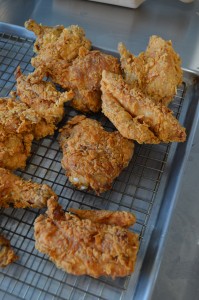 Usually I don’t post about something til I’m confident I have a best practice down pat. I have to say that there’s one important point in my fried chicken technique that I am waffling on: I’m torn between the winning flavour of buttermilk-brined chicken, and the superior texture of dry-rubbed chicken.
Usually I don’t post about something til I’m confident I have a best practice down pat. I have to say that there’s one important point in my fried chicken technique that I am waffling on: I’m torn between the winning flavour of buttermilk-brined chicken, and the superior texture of dry-rubbed chicken.
The Chicken. Frying chicken is a bit of a balancing act: you want the crust to develop the perfect, deep golden brown at the very instant the meat reaches the proper temperature. If you were to take an entire leg from a large chicken and deep fry it, the exterior would get much too dark by the time the meat cooked through.[1]
For this reason I like … Continue reading.


